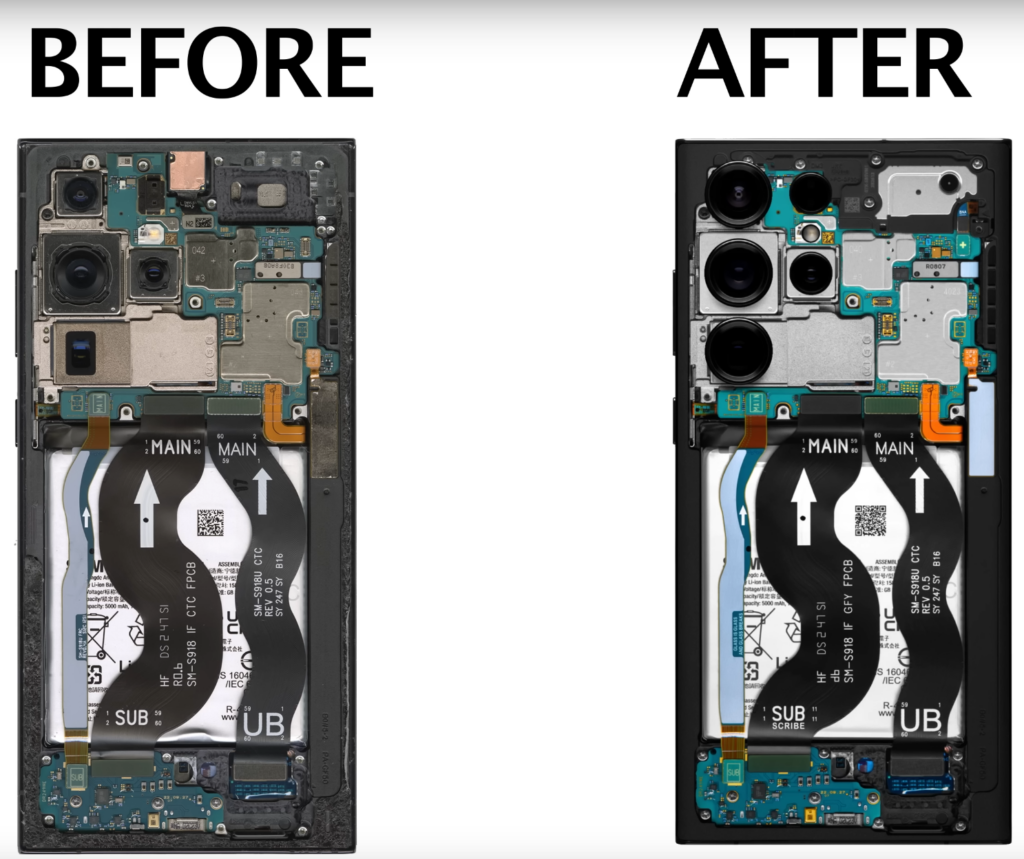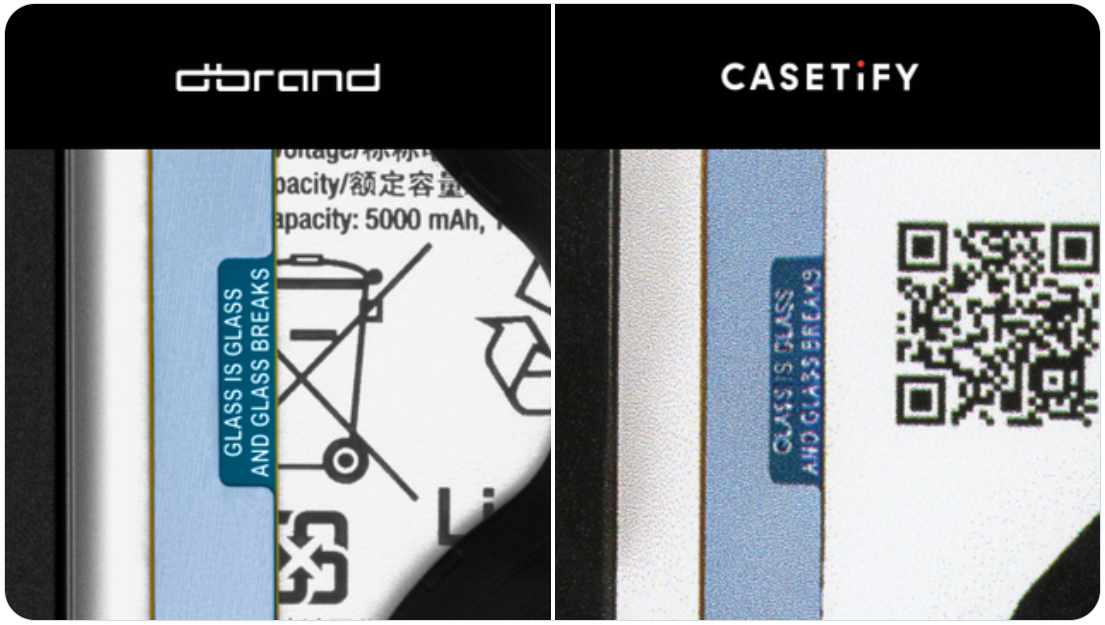All of my opinions are italicized and sources are in blue.
Accessory maker dbrand has filed a “multi-million dollar” lawsuit against Casetify for allegedly ripping off the designs of its “transparent” Teardown products. The skins and cases, created in collaboration with YouTuber Zack “JerryRigEverything” Nelson, are designed to look like the guts of the device they’re applied to, such as smartphones, laptops and gaming systems. dbrand and Nelson claim Casetify stole these designs for its “Inside Out” line.
According to Nelson, he and dbrand “go to extreme lengths to ensure that every Teardown skin is an accurate representation of the inside of each device”. In his video about the lawsuit and a thread on Twitter, he points out that they add several Easter eggs for fans to find. For example, on the Samsung S23 Ultra, dBrand added the phrase “GLASS IS GLASS AND GLASS BREAKS”, which is something that Nelson says all the time. This catch-phrase does not appear on the inside of any smartphone, yet, as dbrand showed in a tweet, it appears in Casetify’s case.

In his video, Nelson says the saga stems back to earlier this year, when a Twitter user claimed Casetify was selling a “transparent” case for a Samsung phone that displays the internals of an iPhone. dbrand poked fun at Casetify for the apparent slip up.
Casetify later rolled out the Inside Out line, which appeared to have more accurate representations of the guts of the devices they’re marketed for. Nelson points out that after using a highly detailed scanner to create a copy of the internals of a device, the Teardown team spends several hours cleaning up the scan. It even takes some creative liberties, such as exposing a charging coil to make a case look more appealing. According to Nelson and dbrand, Casetify’s Inside Out skins and cases match up exactly with the modified designs they used for the Teardown line.
By Thursday afternoon, a few hours after Nelson and dbrand published their accusations, Casetify had pulled every Inside Out product from its website. Meanwhile, dbrand and Nelson took the opportunity to unveil a new set of X-ray skins.
“Casetify has always been a bastion of originality, and we hold pride in that,” the company said in a statement. “We are currently investigating a copyright allegation against us. We have immediately removed the design in question from all platforms. We are also investigating a DDOS attack that disrupted our website around the time the allegation surfaced. All systems are back to normal. All customer information is safe.”
Sunbird has been promising iMessage support on Android for about a year now, but the company has always seemed rather sketchy. Now, as Nothing Chats, built on Sunbird, has launched, the privacy nightmare is coming true – not only is the app not end-to-end encrypted as promised, but image files from other users are pretty easy to access in plain text.
The promise of Sunbird and, in turn, Nothing Chats is to deliver iMessage support to Android. This is done by having users log into their Apple ID through the app which routes the login through a Mac server farm. It’s not a unique method, but the big differentiator here is that Sunbird has made a big deal out of claiming that end-to-end encryption is kept in place throughout the whole process.
On Sunbird’s website it directly says:
The Sunbird servers do not store user data promoting a safe, secure, and private messaging environment. With end-to-end encrypted, confidential messaging, Sunbird is fully secure and completely private.
By adding encryption between Android and iMessage where there currently is none, Sunbird is the first of its kind to give a unified and safe messaging experience to Android users.
Nothing reiterates this on a landing page for Nothing Chats, saying:
Nothing Chats is built on Sunbird’s platform and all Chats messages are end-to-end encrypted, meaning neither we nor Sunbird can access the messages you’re sending and receiving.
But, that’s just not true.
Frightening, new findings reveal that Sunbird and Nothing Chats are, in fact, not fully end-to-end encrypted, as user data can be accessed in plain text.
“Wukko” on Twitter published that Nothing Chats sends all media attachments, including user images, to Sentry with links to those attachments visible in plain text. Further, “all” data is sent and stored through Firebase, and it’s also completely unencrypted.
The folks over at Texts.com have also broken this process down in detail. In a blog post, it’s pointed out that it takes a very short bit of code to automate the process of downloading this information. A demo of an iMessage being sent, only for the database to show that “end-to-end encrypted” text in plain text was also shown, as seen below. A proof of concept was also created and published to Github to show how it all works.
As reported by The Verge,
Sam Altman has been fired as CEO of OpenAI, the company announced on Friday.
“Mr. Altman’s departure follows a deliberative review process by the board, which concluded that he was not consistently candid in his communications with the board, hindering its ability to exercise its responsibilities,” the company said in its blog post. “The board no longer has confidence in his ability to continue leading OpenAI.”
Chief technology officer Mira Murati will be the interim CEO, effective immediately. The company will be conducting a search for a permanent CEO successor. When contacted by The Verge, OpenAI’s communications department declined to comment beyond the blog post. Employees at OpenAI found out about the news when it was announced publicly, according to multiple sources.
“I loved my time at OpenAI,” Altman said in a post on Twitter. “It was transformative for me personally, and hopefully the world a little bit.” In a follow-up post, he described the experience of his firing as “sorta like reading your own eulogy while you’re still alive.”
OpenAI’s announcement also said that co-founder and president Greg Brockman will be stepping down as chair of the board but remain at the company. Hours after it was published, Brockman posted to X that he had quit “based on today’s news.”
Later, in another post on X, Brockman said he and Altman were both notified of their removal from the board on Friday by OpenAI co-founder and chief scientist Ilya Sutskever, who is also a board member. “Sam and I are shocked and saddened by what the board did today,” Brockman wrote.
5 days later, Sam Altman will return as CEO of OpenAI, overcoming an attempted boardroom coup that sent the company into chaos over the past several days. Former president Greg Brockman, who quit in protest of Altman’s firing, will return as well.
The company said in a statement late Tuesday that it has an “agreement in principle” for Altman to return alongside a new board composed of Bret Taylor, Larry Summers, and Adam D’Angelo. D’Angelo is a holdover from the previous board that initially fired Altman on Friday. He remains on this new board to give the previous board some representation, we’re told.
People familiar with the negotiations say that the main job of this small initial board is to vet and appoint an expanded board of up to nine people that will reset the governance of OpenAI. Microsoft, which has committed to investing billions in the company, wants to have a seat on that expanded board, as does Altman himself. During a press tour this week, CEO Satya Nadella said the company didn’t want any more “surprises.”
Xbox user triddel24 ended up posting some evidence of this to the Xbox One subreddit yesterday, showing that when they tried to enter the map in Assassin’s Creed Odyssey, they were first presented with a Black Friday deal for Mirage
This seems to be a very rare occurrence because no media outlets have been able to recreate this. but there are reports from multiple people who have come across it on Xbox, PlayStation and PC, despite it seemingly being quite rare.
On Friday, Ubisoft shared on its’ Assassin’s Creed Twitter account that these ads were “the result of a technical error that has now been fixed”. While it was never Ubisoft’s intention to show ads during gameplay, they still intended to show you these ads. Later in the tweet, they stated that their “intention was to display a promotion for Assassin’s Creed Mirage as part of the franchise news in the main menu of other Assassin’s Creed games”.
As reported by Ars Technica,
Lenovo filed a lawsuit against AsusTek Computer Inc. and Asus Computer International, claiming that Asus’ laptops infringe on four of Lenovo’s patents. Lenovo is seeking damages and for Asus to stop selling Zenbook laptops and other allegedly infringing products in the US.
The lawsuit [PDF] filed November 15 in the US District Court for the Northern District of California says Lenovo’s looking for a jury trial and “damages, including lost profits, caused by the alleged patent infringement.” On Tuesday, Lenovo announced that it filed a patent infringement action against Asus with the US International Trade Commission (ITC).
The lawsuit centers on four patents. The first, entitled “Methods and apparatus for transmitting in resource blocks” was issued in 2021 and relates to minimizing the delay experienced during an uplink package transmission by reducing the number of steps for a wireless device to upload data.
Lenovo’s lawsuit, which uses Asus’ Zenbook Pro 14 OLED (UX6404) as an example of an allegedly infringing product, also claims Asus is selling laptops that violate the wireless wake-on-LAN power management patent issued to Lenovo in 2010.
“For example, prior to the ʼ066 Patent, there existed a need for techniques to supply main power to devices included in a wireless LAN without intervention of an operator. … The invention includes a wireless receiver that receives a wireless signal,” the lawsuit says. It continues, explaining: “The receiver is connected to a main system whose power is not on,” and that “after receiving a signal, it is determined whether a magic packet is contained.” If the magic packet is present, “a signal is sent to turn on the main power supply to the main system.” The lawsuit notes that the tech doesn’t need a handshake with the wireless access point.
Another patent Lenovo is suing over was issued in 2010 and entitled “Touchpad diagonal scrolling.” It allows users to “initiate a diagonal scroll at any location on a touchpad by using two fingers,” the lawsuit says.
“For example, the Accused Products support applications, such as Google Chrome and Adobe Acrobat, and incorporate hardware and firmware in their touchpads, which are specially made or adapted to practice the invention claimed in … the ’189 Patent,” Lenovo’s claim reads.
Finally, Lenovo is upset about Asus’ purported infringing of its “Dual shaft hinge with angle timing shaft mechanism” patent rewarded in 2014. Lenovo describes it as a hinge block enabling 2-in-1 laptops to go from clamshell mode to tablet mode. For this accused patent infringement, Lenovo’s lawsuit points to Asus’ Zenbook Flip 14 UX461, which Asus advertises as having a 360-degree “ErgoLift” hinge that “lifts and tilts the keyboard into the perfect typing position when the display is rotated into laptop mode.”

